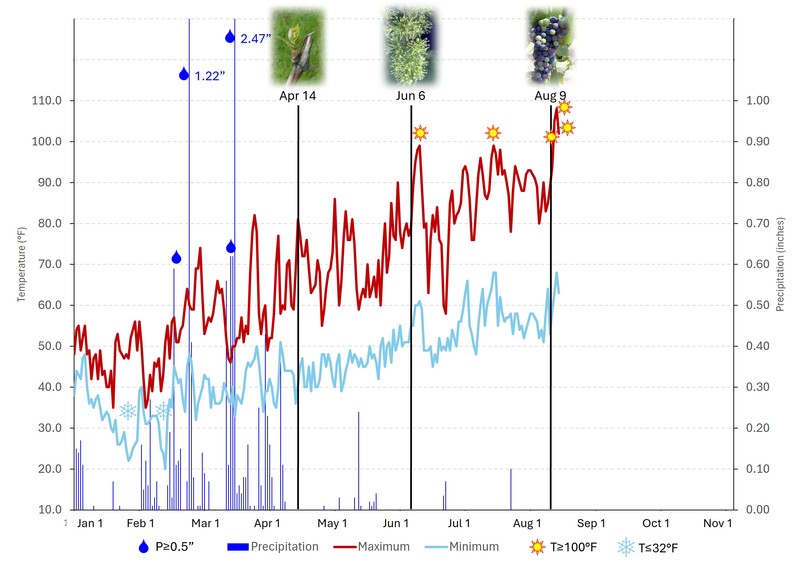Abacela Vintage 2025 – Véraison
Weather and Climate
It has been an interesting year so far in terms of the weather across the western US. While it has been largely warmer than normal for most of the West (0.5 to 4.5 degrees above the average during 1991-2020), the coastal zones from Washington to southern California have experienced a very cool year. This has resulted from the Pacific High being centered further to the west of California than normal, creating strong NNW winds along the coast. This situation produces coastal upwelling of colder water to the surface, which in turn lowers temperatures along the coast and creates enhanced marine layer cloudiness. This effect has been pronounced along the coast, while inland areas have remained much warmer than average. But even while the inland areas have been much warmer than average, this year we have not experienced the degree of extreme heat we have seen in past summers. In addition, the western US has been very dry since April, with most regions running 10-60% of normal rainfall. While this is normally our dry season, it has been exceptionally dry across most of the West.
The Umpqua Valley has seen a largely warmer than average vintage to date, with temperatures in Roseburg running 3.2 degrees above its long-term average. For the water year (October 2024 to July 2025), the Umpqua Valley has seen 5-8% above average precipitation, but it has been exceptionally dry since April 1 with only 1.57” (4.11” below average).
Abacela has mirrored the conditions seen across inland areas of Oregon, experiencing temperatures close to 4 degrees warmer than average (Figure 1). However, up until now, Abacela has seen only two days at or above 100 degrees this year; unfortunately, the heat wave over the last three days brought highs of 105, 108, and 102 degrees. Growing degree days are currently running close to 2100, or 15-20% higher than the average during 1991-2020 and close to 7% higher than the 2024 vintage on the same date. For precipitation, since the beginning of April, Abacela has received only 1.36” of rain, significantly lower than average for this time of year.
Phenology
Abacela tracks phenology, important grapevine growth stages, by block and variety each year. The longest term data that we have comes from eleven variety/block combinations, which include Tempranillo, Syrah, Malbec, Merlot, and Albariño. These observations started in 1997 for Tempranillo and Syrah, with the others added to the observations over time, with all eleven combinations observed since 2010.
For the 2025 vintage, the start of softening, color change, and sugar accumulation, termed véraison, began at Abacela with Tempranillo on August 4th, averaging August 9th across our main varieties (Figure 1). The 2025 vintage véraison is six days earlier than our long-term average of August 15th, continuing accelerated development since a moderately late bud break. While the crop looks very good at this point, the three day extreme heat over the last few days appears to have caused some sunburn in some varieties and blocks. As the fruit starts to soften, it is very susceptible to sunburn, and unfortunately, the timing of extreme heat has come at the worst possible time. The vineyard team was ahead of this heat wave, putting shade cloth on those rows and varieties most susceptible, just hoping it was enough to provide some protection. From this point to harvest, the fruit will increase in size, take on more sugar, respire acids, and develop flavors. Given the timing of véraison at Abacela, we would expect harvest to begin around mid-September and continue through early October.

Figure 1 – Weather and phenological observations for Abacela from January through mid-August 2025. Daily maximum and minimum temperatures are shown in red and light blue, respectively, with extremes of days over 100°F or below 32°F indicated by the sun and ice crystal symbols. Daily precipitation is in a darker blue bar, with days receiving greater than 0.5” of rain indicated with a raindrop. The weather data comes from our main weather station on Cobblestone Hill. The phenological events and days between events come from an eleven variety/block combination of Tempranillo, Syrah, Malbec, Merlot, and Albariño.
